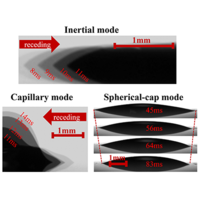当前位置:
X-MOL 学术
›
Phys. Rev. Fluids
›
论文详情
Our official English website, www.x-mol.net, welcomes your feedback! (Note: you will need to create a separate account there.)
Retraction dynamics of water droplets after impacting upon solid surfaces from hydrophilic to superhydrophobic
Physical Review Fluids ( IF 2.7 ) Pub Date : 2020-03-10 , DOI: 10.1103/physrevfluids.5.033604 Fujun Wang , Tiegang Fang
Physical Review Fluids ( IF 2.7 ) Pub Date : 2020-03-10 , DOI: 10.1103/physrevfluids.5.033604 Fujun Wang , Tiegang Fang

|
Although droplet retraction is involved in many applications, it receives less attention than droplet spreading. We present a detailed study of the retraction dynamics for water droplets with varying velocities impacting onto surfaces ranging from hydrophilic to superhydrophobic. The morphologies of retracting droplets are compared in detail. Two distinct retraction modes are classified: the inertial mode and the capillary mode. The retracting droplet with an inertial mode features a rim-lamella structure with a slowly decreasing dynamic receding contact angle while the capillary mode shows a collapsed rim and lamella and capillary wave propagation. During the retraction process, the inertial mode first takes place, and then the capillary mode occurs at a later stage. The inertial mode becomes more dominant with increasing impacting velocities. The dependencies of the retraction rate on impacting velocities and surface wettabilities are justified from the experimental measurements. The inertial-mode retraction rate increases with increasing velocity, while the capillary-mode retraction rate decreases. The retraction rate is generally higher for more hydrophobic surfaces, and its dependence on impacting velocities becomes stronger. An improved shape assumption for the retracting droplet is proposed by introducing an averaged dynamic receding contact angle and a shape factor. This semiempirical model can well explain the dependency of the inertial-mode retraction rate on impacting velocities for water droplets. Last but not the least, the normalized retraction curves generally collapse into a universal curve, revealing certain similarity behaviors for the droplet retraction on solid surfaces.
中文翻译:

水滴撞击固体表面后从亲水性到超疏水性的回缩动力学
尽管液滴回缩涉及许多应用,但与液滴扩散相比,它受到的关注较少。我们目前对水滴回缩动力学的详细研究,这些水滴以不同的速度撞击从亲水到超疏水的表面。详细比较了缩回液滴的形态。分为两种不同的缩回模式:惯性模式和毛细管模式。具有惯性模式的回缩液滴的特征是边缘薄片结构,其动态后退接触角逐渐减小,而毛细管模式则显示边缘和薄片塌陷以及毛细管波传播。在缩回过程中,首先发生惯性模式,然后在随后的阶段发生毛细管模式。随着冲击速度的增加,惯性模式变得越来越占优势。缩回速率对冲击速度和表面润湿性的依赖性从实验测量中是合理的。惯性模式回缩率随速度增加而增加,而毛细管模式回缩率则下降。对于更疏水的表面,回缩速率通常较高,并且其对冲击速度的依赖性变得更强。通过引入平均动态后退接触角和形状因数,提出了一种用于缩回液滴的改进形状假设。这个半经验模型可以很好地解释惯性模式回缩率对水滴撞击速度的依赖性。最后但并非最不重要的一点是,归一化的收缩曲线通常会塌陷为通用曲线,
更新日期:2020-03-10
中文翻译:

水滴撞击固体表面后从亲水性到超疏水性的回缩动力学
尽管液滴回缩涉及许多应用,但与液滴扩散相比,它受到的关注较少。我们目前对水滴回缩动力学的详细研究,这些水滴以不同的速度撞击从亲水到超疏水的表面。详细比较了缩回液滴的形态。分为两种不同的缩回模式:惯性模式和毛细管模式。具有惯性模式的回缩液滴的特征是边缘薄片结构,其动态后退接触角逐渐减小,而毛细管模式则显示边缘和薄片塌陷以及毛细管波传播。在缩回过程中,首先发生惯性模式,然后在随后的阶段发生毛细管模式。随着冲击速度的增加,惯性模式变得越来越占优势。缩回速率对冲击速度和表面润湿性的依赖性从实验测量中是合理的。惯性模式回缩率随速度增加而增加,而毛细管模式回缩率则下降。对于更疏水的表面,回缩速率通常较高,并且其对冲击速度的依赖性变得更强。通过引入平均动态后退接触角和形状因数,提出了一种用于缩回液滴的改进形状假设。这个半经验模型可以很好地解释惯性模式回缩率对水滴撞击速度的依赖性。最后但并非最不重要的一点是,归一化的收缩曲线通常会塌陷为通用曲线,


























 京公网安备 11010802027423号
京公网安备 11010802027423号